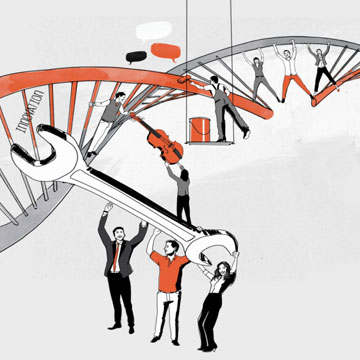
Human DNA in Innovation
Understanding Thought Leadership in Organizational Context
Thought leadership within an organizational framework extends beyond mere expertise or traditional leadership roles. It encapsulates the ability to innovate, possess a forward-thinking vision, and significantly influence industry practices and organizational behavior. Unlike standard leadership, which often focuses on managing people and processes, thought leadership emphasizes the dissemination of revolutionary ideas and pioneering approaches that can propel an organization toward enhanced effectiveness and industry prominence.
Qualities that distinguish a thought leader include a robust capability for innovation, a distinctive visionary outlook, and a compelling influence that inspires stakeholders across various levels. Thought leaders proactively seek and embrace cutting-edge trends, leveraging these insights to drive significant strategic initiatives within their organizations. They not only forecast future trends but also articulate these ideas in ways that bolster organizational learning and adaptability.
Real-world instances of thought leadership can be observed in various influential organizations. For example, Steve Jobs at Apple epitomized thought leadership by consistently pushing the boundaries of technology and design, which fundamentally transformed the consumer electronics industry and fortified Apple’s market position. His vision and relentless drive for innovation facilitated a culture where disruptive ideas flourished, leading to the development of groundbreaking products like the iPhone, which has markedly improved organizational effectiveness and market share.
Another illustrative case is Indra Nooyi at PepsiCo, whose thought leadership transcended conventional business strategies. By advocating for healthier product alternatives and sustainable business practices, Nooyi not only enhanced PepsiCo’s brand image but also set a precedent for industry standards in corporate responsibility. Her foresight and strategic decision-making reflect the core attributes of a thought leader—to advance industry norms and contribute broadly to societal well-being.
The essence of thought leadership lies in continuous learning and staying ahead of industry trends. Thought leaders habitually engage in ongoing education, continuously expanding their knowledge and refining their strategies to address evolving challenges and opportunities. This commitment to perpetual growth and their proclivity for groundbreaking ideas profoundly impact organizational effectiveness and long-term success.
“`
Implementing Thought Leadership for Organizational Success
Fostering thought leadership within an organization is a multifaceted endeavor that requires strategic planning and dedicated effort. One of the fundamental steps in promoting a culture of thought leadership is the establishment of open communication channels. Leaders and managers must create an environment where team members feel comfortable sharing their ideas and insights. This can be achieved through regular meetings, brainstorming sessions, and using collaborative tools that facilitate idea exchange. Furthermore, encouraging innovative thinking is crucial; leaders should reward creativity and recognize employees who propose new solutions and approaches.
Investing in professional development is another vital strategy. Providing opportunities for continuous learning through workshops, seminars, and online courses can help employees stay abreast of industry trends and enhance their expertise. By fostering a learning culture, organizations not only improve their knowledge base but also stimulate intellectual growth among their workforce.
Integrating thought leadership into strategic planning and decision-making processes can significantly drive organizational success. Leaders should involve key thinkers in strategy discussions and consider their insights when shaping the organization’s direction. This collaborative approach ensures that diverse perspectives are reflected in the company’s objectives and strategies, which can lead to more informed and innovative decisions.
However, implementing thought leadership is not without challenges. Resistance to change and difficulty in shifting established mindsets are common obstacles. Organizations can address these issues by clearly communicating the benefits of thought leadership and involving employees in the change process. Additionally, setting up frameworks such as innovation task forces or leadership development programs can help mitigate resistance and ease the transition.
Examples of actionable tactics include leveraging thought leadership to enhance employee engagement. By involving employees in thought leadership activities, they feel valued and more connected to the company’s mission, which can boost morale and productivity. Improving operational efficiency is another area where thought leadership can have a significant impact. Innovators within the organization can identify bottlenecks and propose effective solutions, leading to smoother operations and cost savings.
In summary, implementing thought leadership involves a combination of open communication, fostering innovation, investing in professional development, and integrating it into strategic planning. By addressing potential challenges and leveraging practical tactics, organizations can enhance their overall effectiveness, achieve long-term goals, and secure a competitive edge in their industry.



